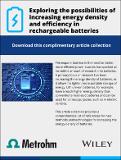Files in this item
The exsolution of Cu particles from doped barium cerate zirconate via barium cuprate intermediate phases
Item metadata
| dc.contributor.author | Wang, Mei | |
| dc.contributor.author | Papaioannou, Evangelos | |
| dc.contributor.author | Metcalfe, Ian | |
| dc.contributor.author | Naden, Aaron B. | |
| dc.contributor.author | Savaniu, Cristian D. | |
| dc.contributor.author | Irvine, John T. S. | |
| dc.date.accessioned | 2023-05-03T09:30:04Z | |
| dc.date.available | 2023-05-03T09:30:04Z | |
| dc.date.issued | 2023-07-04 | |
| dc.identifier | 283588352 | |
| dc.identifier | a8162c37-8247-4111-a36a-714c2723665b | |
| dc.identifier | 85153600612 | |
| dc.identifier.citation | Wang , M , Papaioannou , E , Metcalfe , I , Naden , A B , Savaniu , C D & Irvine , J T S 2023 , ' The exsolution of Cu particles from doped barium cerate zirconate via barium cuprate intermediate phases ' , Advanced Functional Materials , vol. 33 , no. 27 , 2302102 . https://doi.org/10.1002/adfm.202302102 | en |
| dc.identifier.issn | 1616-301X | |
| dc.identifier.other | ORCID: /0000-0002-8394-3359/work/134055309 | |
| dc.identifier.other | ORCID: /0000-0003-2876-6991/work/134056029 | |
| dc.identifier.uri | https://hdl.handle.net/10023/27490 | |
| dc.description | Funding: This research was supported by EPSRC research grants EP/R023522/1, EP/T019298/1, EP/R023751/1, EP/L017008/1 the China Scholarship Commission (MW) received financial support from the UK Catalysis Hub funded by EPSRC Grant reference EP/R027129/1. | en |
| dc.description.abstract | As a low-cost alternative to noble metals, Cu plays an important role in industrial catalysis, such as water-gas shift reaction, methanol or ethanol oxidation, hydrogenation of oils, CO oxidation, among many others. An important step in optimizing Cu catalyst performance is control of nanoparticles size, distribution, and the interface with the support. While proton conducting perovskites can enhance the metal catalytic activity when acting as the support, there has been limited investigation of in situ growth of Cu metal nanoparticles from the proton conductors and its catalytic performance. Here, Cu nanoparticles are tracked exsolved from an A-site-deficient proton-conducting barium cerate-zirconate using scanning electron microscopy, revealing a continuous phase change during exsolution as a function of reduction temperature. Combined with the phase diagram and cell parameter change during reduction, a new exsolution mechanism is proposed for the first time which provides insight into tailoring metal particles interfaces at proton conducting oxide surfaces. Furthermore, the catalytic behavior in the CO oxidation reaction is explored and, it is observed that these new nanostructures can rival state of the art catalysts over long term operation. | |
| dc.format.extent | 12 | |
| dc.format.extent | 3654971 | |
| dc.language.iso | eng | |
| dc.relation.ispartof | Advanced Functional Materials | en |
| dc.subject | CO oxidation | en |
| dc.subject | Eutectic | en |
| dc.subject | Exsolution | en |
| dc.subject | Nanoparticles | en |
| dc.subject | Phase diagrams | en |
| dc.subject | Proton conductors | en |
| dc.subject | QD Chemistry | en |
| dc.subject | NDAS | en |
| dc.subject | MCC | en |
| dc.subject.lcc | QD | en |
| dc.title | The exsolution of Cu particles from doped barium cerate zirconate via barium cuprate intermediate phases | en |
| dc.type | Journal article | en |
| dc.contributor.sponsor | EPSRC | en |
| dc.contributor.sponsor | EPSRC | en |
| dc.contributor.sponsor | EPSRC | en |
| dc.contributor.sponsor | EPSRC | en |
| dc.contributor.institution | University of St Andrews. Centre for Energy Ethics | en |
| dc.contributor.institution | University of St Andrews. Centre for Designer Quantum Materials | en |
| dc.contributor.institution | University of St Andrews. School of Chemistry | en |
| dc.contributor.institution | University of St Andrews. EaSTCHEM | en |
| dc.contributor.institution | University of St Andrews. Institute of Behavioural and Neural Sciences | en |
| dc.identifier.doi | https://doi.org/10.1002/adfm.202302102 | |
| dc.description.status | Peer reviewed | en |
| dc.identifier.grantnumber | EP/R023522/1 | en |
| dc.identifier.grantnumber | EP/T019298/1 | en |
| dc.identifier.grantnumber | EP/R023751/1 | en |
| dc.identifier.grantnumber | ep/l017008/1 | en |
This item appears in the following Collection(s)
Items in the St Andrews Research Repository are protected by copyright, with all rights reserved, unless otherwise indicated.

